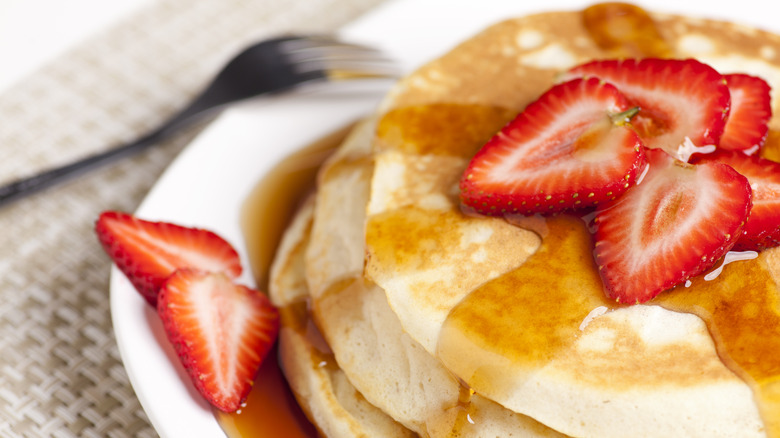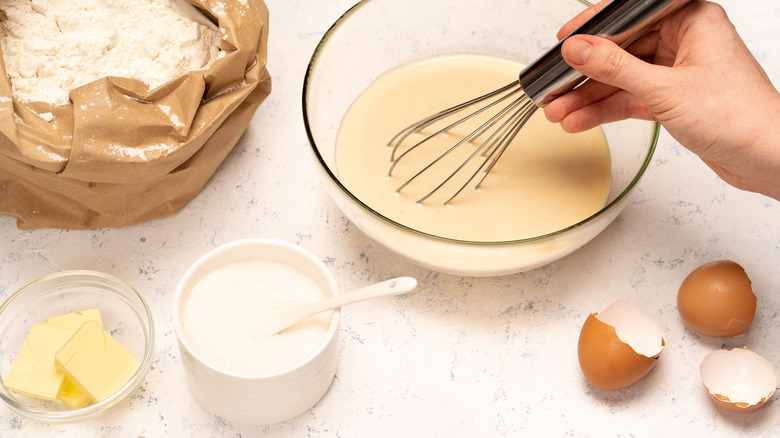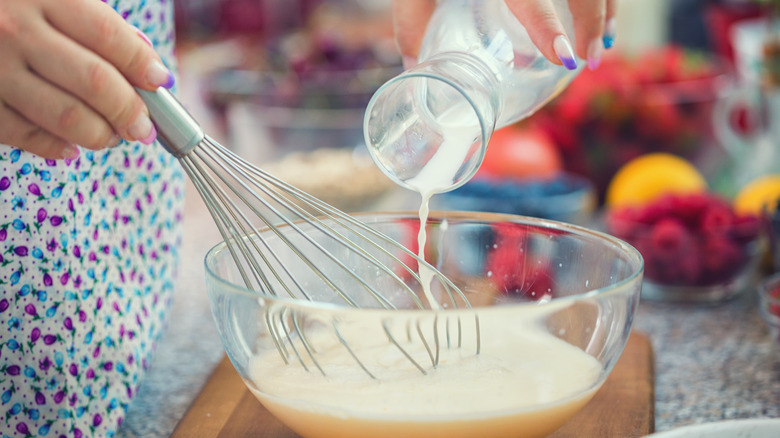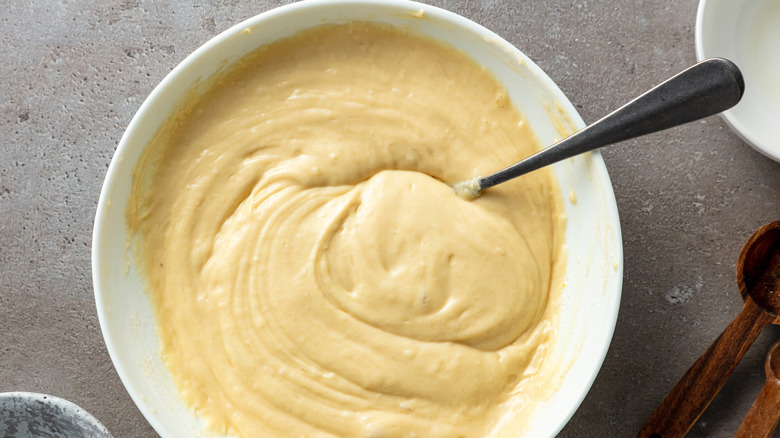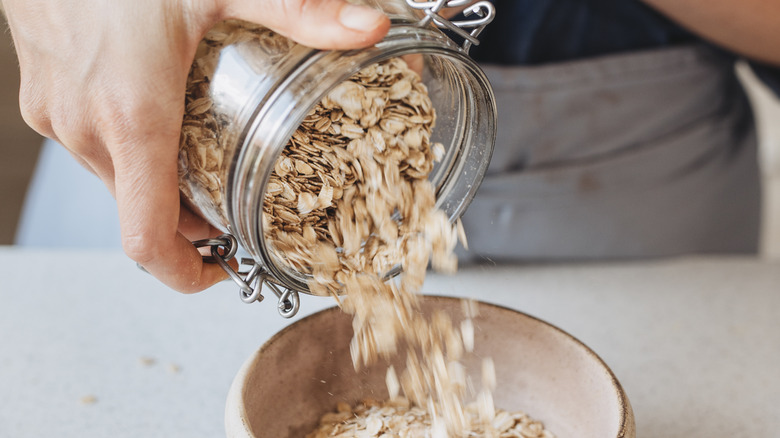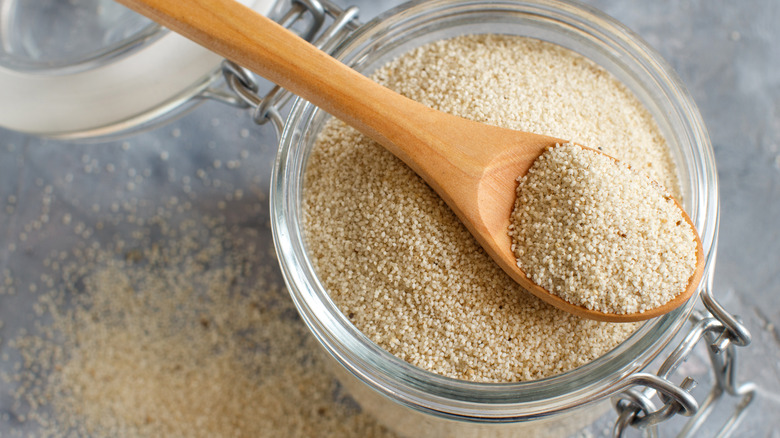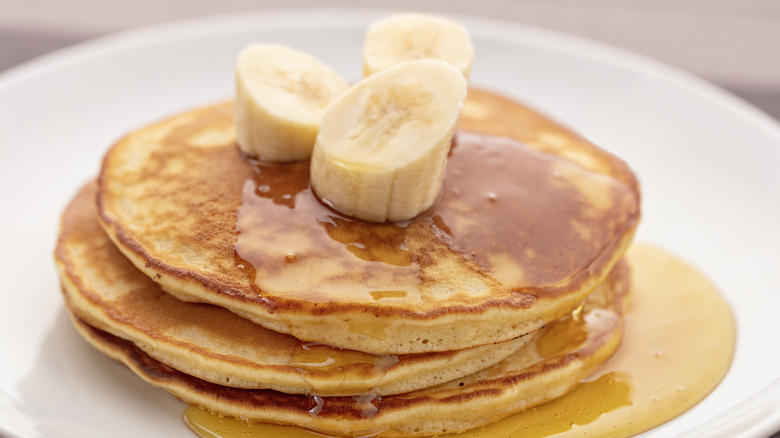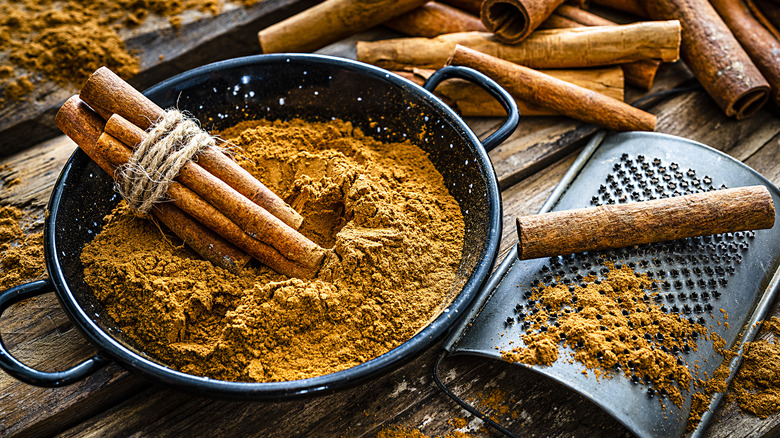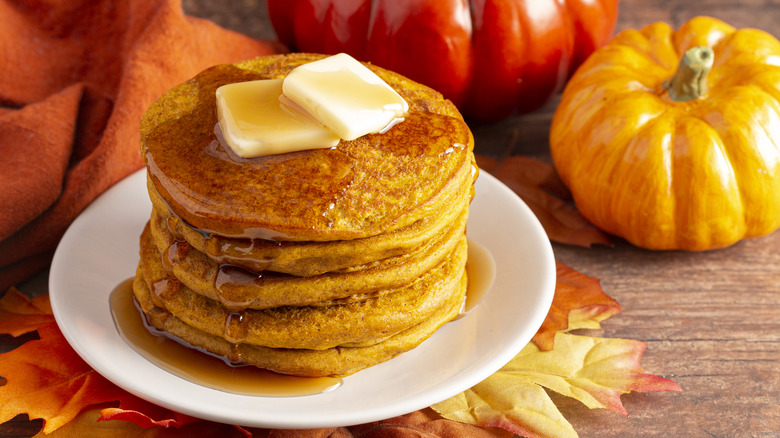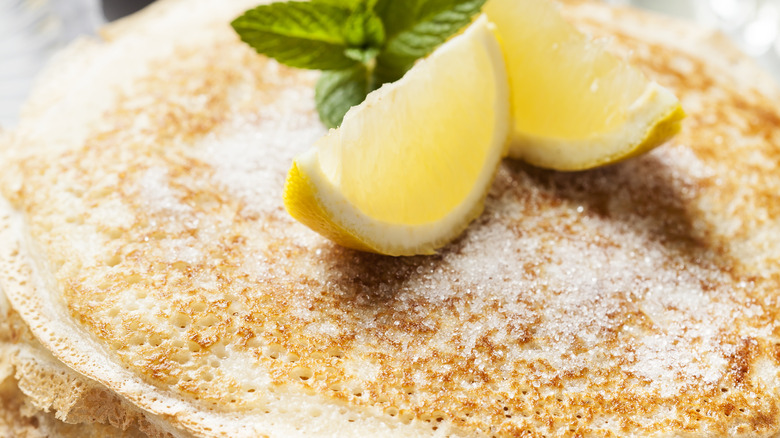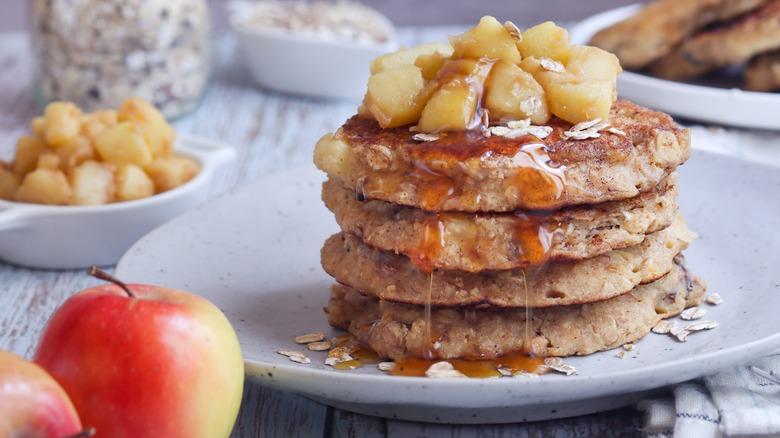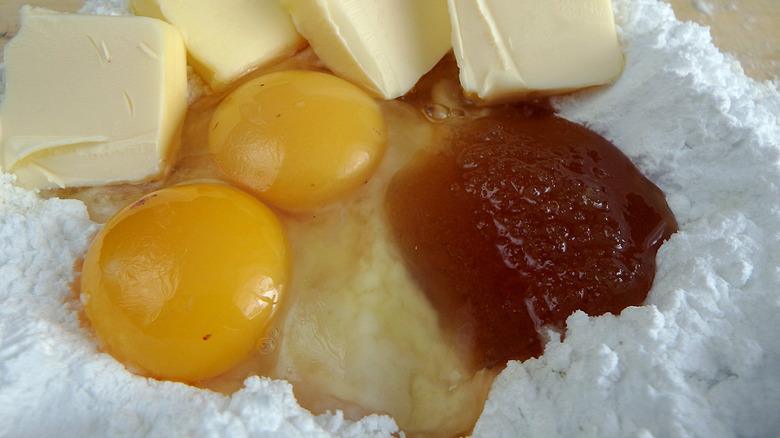Delicious Ingredients That Will Change The Way You Make Pancakes
When it comes to breakfast, pancakes might just be the most delicious thing you can serve up to start your day. The batter comes together quickly, they cook in minutes, and kids love 'em. Perhaps best of all, they don't require a lot of ingredients. Of course, you could use a mix, but if you have a few basics in your fridge and pantry, you won't even need that.
To whip up the batter for a batch of light, fluffy, golden, and incredible pancakes, simply mix 1 cup of flour, 2 teaspoons baking powder, 1 to 2 tablespoons of sugar, ½ teaspoon salt, 1 cup of milk, 2 tablespoons butter, and 1 egg. Combine the dry ingredients first. Mix the wet ingredients in a separate bowl, then combine the two, mixing well. Let the batter rest — and thicken — for a few minutes while your griddle heats, and then start making those incredible flapjacks.
And if you really want to impress your friends or family — or you just want to settle down to a mouthwatering stack yourself — you can take that recipe and build on it even further. Perhaps the very best thing about pancakes is the batter is incredibly versatile and can be modified in countless ways. Swap ingredients, stir in extra flavors and textures, or practice some other subtle refinements, and your pancakes will continue to get better. Here are some tasty ideas to help get you started.
1. Experiment with alternate flours
Flour is the backbone of any pancake batter. This ground wheat powder gives the batter form, texture, and volume. It makes up the structure of the pancake once it's cooked, creating the thickness — and the fluffiness — that make pancakes so scrumptious to dig into. Flour absorbs the moisture in the pancake batter, and it's also what browns and crisps as the pancakes cook. It truly is the fundamental building block all pancakes are built around.
But when making pancake batter, you don't need to limit yourself to traditional wheat flour. The world is full of incredible grains, many of which can be used to make out-of-this-world pancakes.
For instance, almond flour is naturally gluten-free and is a beautiful option to swap in place of regular flour to make pancakes with an intense, nutty flavor. You can replace it in a one-to-one ratio for wheat-based flour. Coconut flour is a great option that increases the fiber content of your pancakes while also helping to make them lower carb — and it imparts a subtle coconut taste in the process.
You can use buckwheat flour for pancakes that are earthier and slightly more dense, or chickpea flour to make your pancakes higher in protein. And if you do stick with wheat-based flour, don't forget you have options there, too. Cake flour is more finely milled and will make for lighter, more tender pancakes while pastry flour may yield pancakes that are fluffier overall.
2. Use buttermilk in your batter
Just as flour forms the substance of pancakes, milk provides the moisture necessary to turn that flour into a batter. It makes pancake batter pourable and easy to spread on a griddle or pan. And it provides protein and fat, both of which contribute to your pancakes' overall flavor and richness.
But just as flour can be replaced in many pancake recipes, so too can milk. Almond milk, soy milk, and coconut milk are all good milk substitutes when making pancake batter. Perhaps the best substitute of all for milk is its tangy, southern cousin — buttermilk.
For those who aren't familiar, buttermilk is the liquid leftover after you churn butter. It has a higher acidity than regular milk, creating a more significant reaction with the baking soda in most pancake batter recipes, helping to make pancakes that are lighter and fluffier overall. Buttermilk also adds a hint of sourness to pancakes, which can be a delicious complement to the fat in butter or the sugar in syrup that you might spread over your buttermilk pancakes. And because buttermilk tenderizes, it also creates softer, more delicate pancakes.
Don't have any buttermilk on hand? No problem. There are easy ways to make buttermilk substitutes that are just as effective when baking. One of the simplest is to add 1 tablespoon of either vinegar or lemon juice to 1 cup of milk and then let stand at room temperature for 15 minutes. Voila, instant buttermilk!
3. Add Greek yogurt or ricotta to your recipe
While thinking about substitutes for the dairy in your pancake batter, remember your substitutions don't all have to be in liquid form. Greek yogurt is another wonderful option to include in pancake batter. It creates extra moist pancakes and gives your batter a thick and rich consistency. The yogurt also boosts the protein content of your pancakes and gives them a fantastic, unexpected hint of tang.
Substitute Greek yogurt instead of milk in a one-to-one ratio, and then make your pancakes like normal after mixing. If you're using an uber-thick Greek yogurt or the batter seems too thick to pour easily onto your griddle, add a splash of water or milk to make it a bit runnier. Plain yogurt can also be used in place of Greek for similar results. You can use plain yogurts, vanilla-flavored yogurts, and even most fruit and berry-flavored yogurts as well. Each can lend your pancake a unique and sometimes unexpected flavor profile.
Finally, ricotta cheese — the Italian cheese made from whey often left over from the production of other cheeses — is another excellent alternate dairy source for your pancakes. You can swap it cup for cup for milk in your recipe. Or, do a partial substitution — for instance, if your recipe calls for 1 cup of milk, add ½ cup milk and ½ cup ricotta. Like Greek yogurt, ricotta again helps make pancakes soft and luscious and provides a slightly sweet, nutty flavor to your batter.
4. Mix in rolled oats
Oatmeal is another breakfast favorite. It's high in fiber, hearty, filling, and takes on various flavors wonderfully. So why not add rolled oats to your pancake batter and get the best of both worlds?
Rolled oat pancakes have a unique, chewy texture, making them feel more substantial and satisfying than traditional pancakes. They're also naturally nutty and pack a subtle sweetness that adds depth and complexity to standard pancake batter.
Adding rolled oats to pancake batter also couldn't be easier. First, make sure you are starting with the right type of oats. You want old-fashioned oats, not instant or steel-cut. Add ¼ to ½ cup per 1 cup of flour in your pancake batter recipe. For chewier pancakes, add your rolled oats directly into your batter as you mix everything. Let your oats soak for five to 10 minutes in your liquid mixture before combining liquid and dry ingredients for slightly less dense pancakes. Add ¼ to ½ cup per 1 cup of flour in your pancake batter recipe.
If your batter seems too thick once mixed, add a splash of milk or water to help compensate for the moisture the oats absorbed. And remember to let your batter rest for a few minutes before cooking. This will give the oats time to soften and ensure a more consistent texture in your pancakes. To complement that naturally oaty goodness further, combine chopped nuts, dried fruit, or chocolate chips into your batter for even more flavor.
5. Fold in some fonio
Like oatmeal, there are many other incredible grains you can add to any pancake batter recipe. And fonio — a West African favorite — is one of the best. This tiny whole grain, which is only slightly larger than kernels of sand, is an ancient crop that was once a mainstay in many diets worldwide, gradually fell out of flavor, and is now making a comeback. With a slightly savory flavor that falls somewhere between quinoa and couscous, we recommend whipping up a batch of the grain to serve with any weeknight meal. Once cooked, adding the grain to your pancake batter couldn't be easier — just mix it in. You can use your leftovers. Add anywhere from ⅓ to ½ cup for a standard recipe, mixing well until it's nicely combined into your traditional batter.
In addition to helping make pancakes more nutritious, fonio is packed with a bounty of protein, fiber, vitamins, and good-for-you minerals — the grain also helps to make pancakes lighter and fluffier. And it's easier to create those delicious crisp and golden edges on pancakes that we all love so much. Plus, it makes pancakes more filling — vital if you're fueling up for a long, hectic weekend.
Other grains that can be cooked in advance and then added to pancake batter to introduce different textures, flavors, and nutritional benefits include quinoa for nuttiness, buckwheat for earthiness, barley for a subtle nuttiness, millet for a mild crunch, and amaranth for a hint of pepper.
6. Whisk a mashed ripe banana into the batter
Looking for a way to naturally reduce the amount of sugar in your pancakes? Or maybe you're just searching for the perfect tropical complement to your morning glass of OJ? Either way, adding mashed banana to your pancake batter can be an ideal way to bring more nutrition and an entirely different flavor profile to your breakfast routine.
Mashed ripe banana adds natural sweetness to any pancake batter, reducing the need for additional sugar. The fruit also adds moisture to the batter, creating wonderfully tender pancakes that also sport banana's mild, distinctive flavor.
To add a banana to any favorite pancake recipe, simply peel your banana and mash it into a smooth purée with a fork. Then, stir the banana pulp into your liquid ingredients. Because you are using the banana, you can eliminate the sugar from your recipe entirely. Or, just use a fraction of the sugar you would have typically used, depending on how sweet you like your pancakes. If the banana-packed batter seems too thick, add a small splash of milk. If it seems too watery, you can add 1 tablespoon of flour at a time until you reach your desired consistency.
When the batter is to your liking, cook your pancakes to their usual golden brown perfection. To round out your meal, top each pancake with a few additional slices of banana, fresh fruit, nut butter, and a drizzle of pure, old-school maple syrup.
7. Stir in spices like cinnamon, nutmeg and even pumpkin pie spice
Spices and baked goods or desserts are a match made in culinary heaven. And the beautiful thing about pancakes is that their batter is an especially easy one to add spices to. You can try any combination of spices you can dream up, and if it doesn't work, it's easy to make a new batch quickly. You can even flavor individual pancakes with different mixtures of spices — perfect for trying out new culinary inspiration or feeding a large group with varied and diverse tastes.
In general, add between ½ to 1 teaspoon of any spice to your pancake batter as a starting point and then work up from there, adding more as needed to reach just the right level of flavor and punch. Sweet warming spices like cinnamon, nutmeg, cardamom, and allspice are excellent options to start with, and each works beautifully as an addition to any pancake batter recipe. You might also consider adding powdered ginger for a hint of zesty pepper. If you like the flavor of black licorice, anise is a no-brainer.
Try 1 teaspoon of turmeric, rosemary, smoked paprika, coriander, fennel seeds, cumin, or even cayenne pepper for an earthier, savory pancake that goes wonderfully with eggs and sausage. And for pancakes that taste more like a full-blown dessert, you can't go wrong with the addition of cocoa powder, chai spice blend, lavender, or even matcha powder.
8. Add pumpkin purée to your recipe
After spices, one of the most flavorful and perhaps unexpected twists you can make with your favorite pancake batter recipe is the addition of some classic veggies. Sure, we all know that berries, cherries, and even raisins are a natural fit to work into any batter — just throw in a handful of fresh or dried fruit and stir.
But adding pumpkin can give your pancakes an entirely different flavor profile, vibe, and even color. It can make the pancakes sweeter or more savory and bitter. It can even turn them from something you only think of serving in the morning to a vital part of any lunch or dinner menu. Adding pumpkin to pancake batter, for instance, creates rich, rustic-tasting pancakes with an herbaceous quality. Best of all, you don't have to make any considerable changes to your recipe to add the pumpkin. Just fold in ½ cup of canned pumpkin purée after combining your wet and dry ingredients, and add a touch of additional flour or milk if your batter seems too dry or runny after the pumpkin is mixed in.
Besides pumpkin, you can use the same folding technique to work mashed sweet potatoes, grated zucchini, grated carrots, or even puréed butternut squash into any pancake batter. Finely chopped spinach, puréed beets, regular mashed potatoes, and even caramelized onion all make excellent, savory pancake batter additions.
9. Use citrus zest – orange, lemon, and lime are all great
In addition to adding veggies to your pancake batter, you can also use a variety of unexpected fruit to make your pancakes tastier. One of the best options, and one that is often underutilized, is the addition of citrus zest.
Zesting is the process of removing the outer, colored peel of any citrus fruit using a fine grater. This outer peel, or "zest" as it is known in the food world, is packed with a variety of essential oils, making it incredibly rich in both flavor and aroma. Zesting is a great way to quickly and easily add concentrated citrus flavor to any food, including pancake batter.
Lemons, limes, oranges of all types, and even grapefruit can all be used. Begin by making your pancake batter as usual. Once you have combined your wet and dry ingredients, select the fruit you'd like to use to flavor your recipe. Wash the fruit, and then — using a zester, fine grater, or microplane — simply grate away the colored zest or peel from the fruit, carefully avoiding the bitter white pith underneath.
You can grate this zest directly into your batter, stirring it when done. Then, cook your pancakes as normal. If you'd like, save a bit of zest and grate it over your pancake fresh right before serving, perhaps with a dollop of whipped cream or a bit of powdered sugar and a wedge of the fresh citrus fruit.
10. Pour in some apple cider
While adding chunks of raw apple to pancake batter generally isn't a great idea — there may not be enough time for the apple to soften and cook before your pancake is done — the addition of a splash (or more) of apple cider to your pancake recipe is one more excellent way to work the goodness of fruits into your morning platter of pancakes.
Apple cider can add the delightful flavor of apples to pancakes, giving them a unique sweetness that only apples bring. You can use apple cider as a one-to-one substitute for part or all of the milk in any pancake recipe. For example, if your standard recipe calls for 1 cup of milk, you can use 1 cup of apple cider instead. Or, for a more mild apple flavor, you can use a 50/50 mix of apple cider and milk.
Add fresh apple juice or even apple sauce if apple cider is not in season. The applesauce can be worked into your batter without any other major recipe substitutions. Just stir in ½ cup to start, just as you could pumpkin purée, and then add more as needed, depending on how much of an apple-flavored punch you are after. Canned apple pie filling could also be folded in a pinch if you don't have any other apples available. But because of the size of the apple slices, it's generally better as a topping than an actual ingredient in your pancake batter.
11. Add a splash of rum (or rum extract)
Finally, while looking for delicious ingredients that will truly change the way you make pancakes, you might draw inspiration from the beloved French dish known as Crêpes Suzette — arguably one of the most famous desserts ever created. The recipe consists of super thin pancakes known as crêpes topped with a boozy butter sauce. And the good news is that you can create similarly flavorful pancakes with a simple splash of rum.
Rum adds a rich and complex blend of caramel, vanilla, and spice to any batter, elevating its taste and creating a delicious aroma that will fill your kitchen while the pancakes cook. To successfully add the rum to any recipe, reduce the amount of liquid in your recipe by 2 ounces and replace that liquid with 2 ounces of your favorite light, dark, or spiced rum. You can also use rum extract. In this case, you don't need to adjust your recipe. Simply add between 1 and 2 teaspoons of rum extract, depending on just how much flavor you're looking for.
Cook your rum-infused pancake batter as usual, spooning it onto a hot griddle or pan and letting it cook until bubbles form on the surface. Then flip and cook the other side until golden brown. In addition to rum, whiskey, brandy, Irish cream, coffee liqueur, and orange liqueur are all excellent pancake batter additions that can forever change how you make pancakes — for the better!

